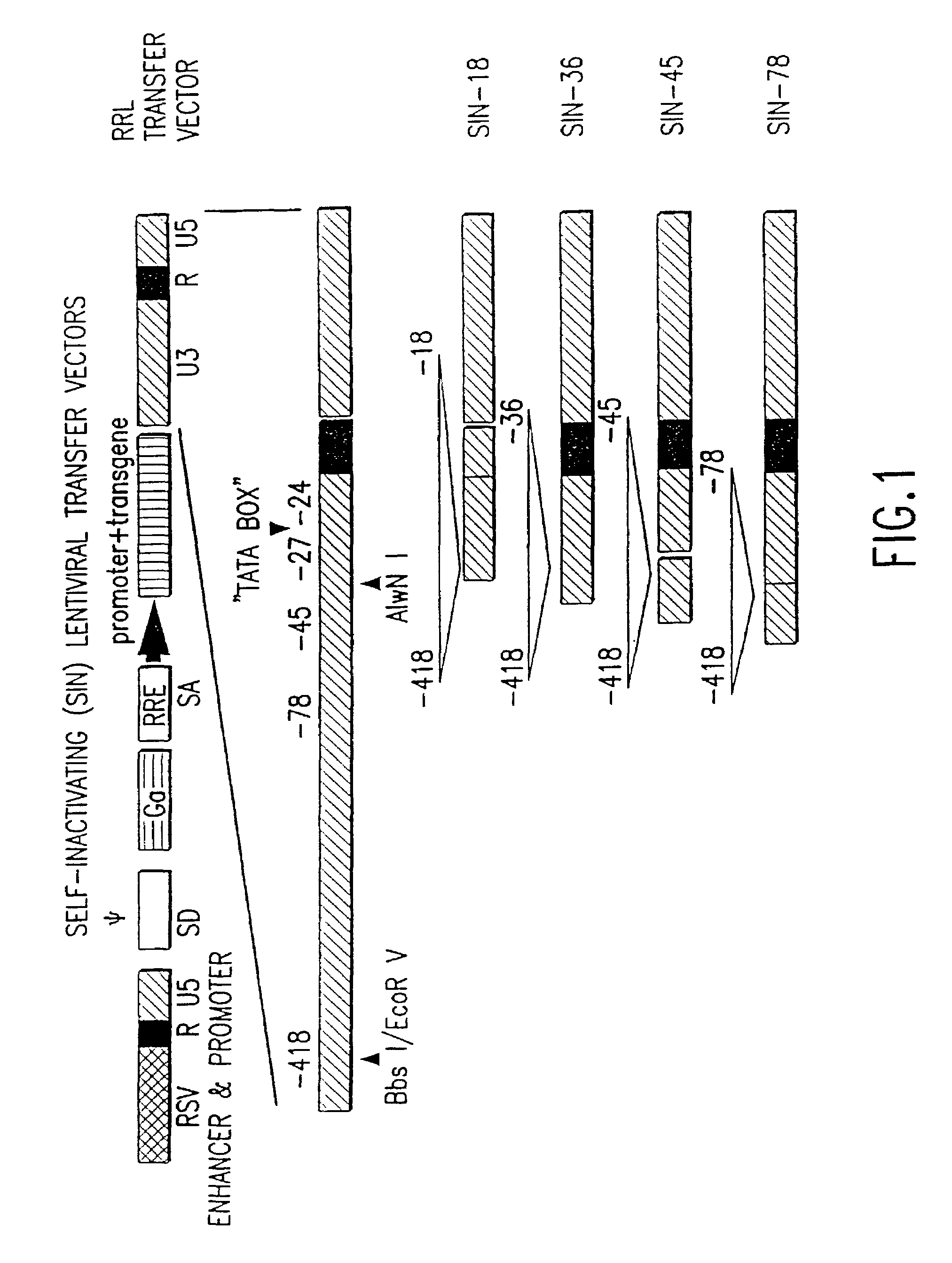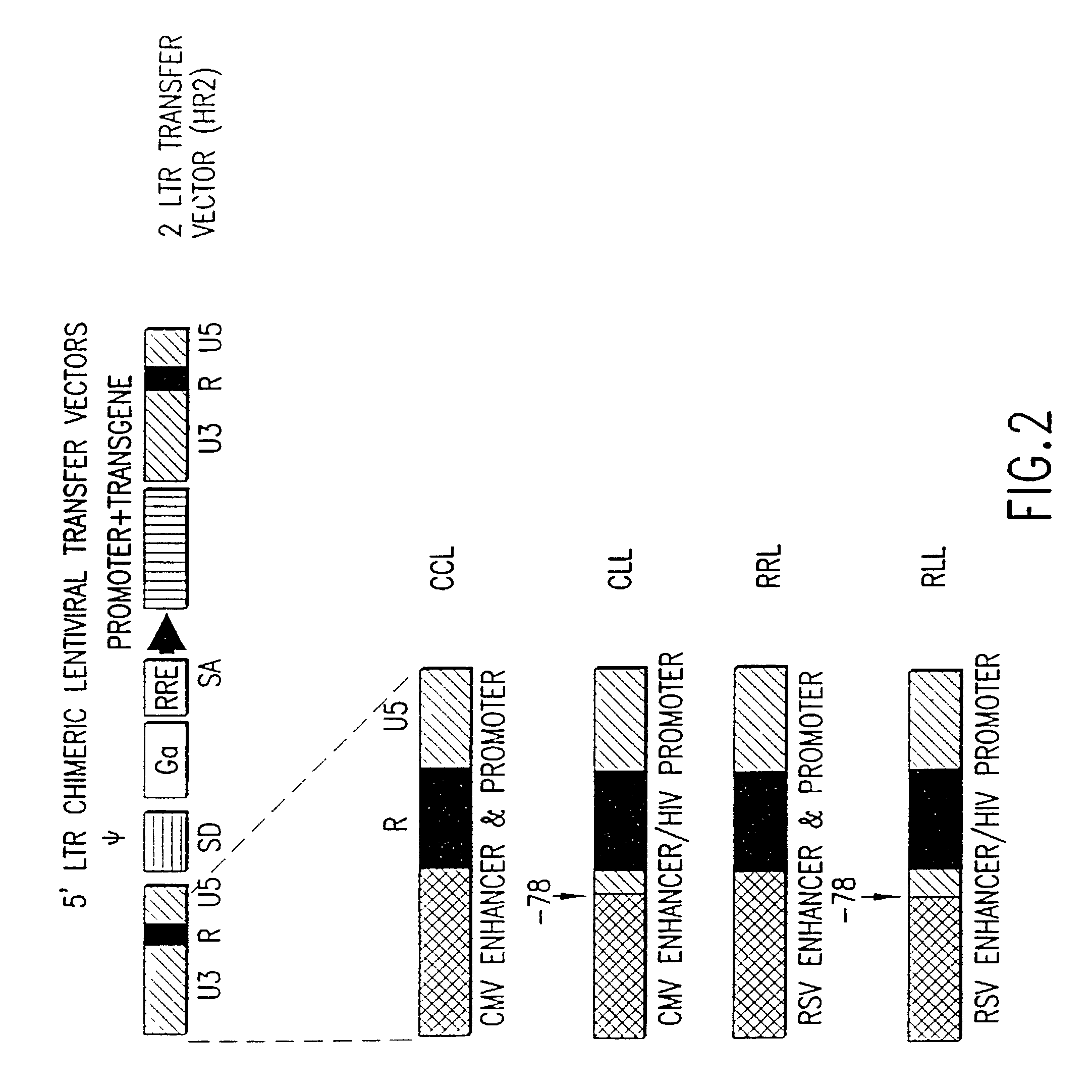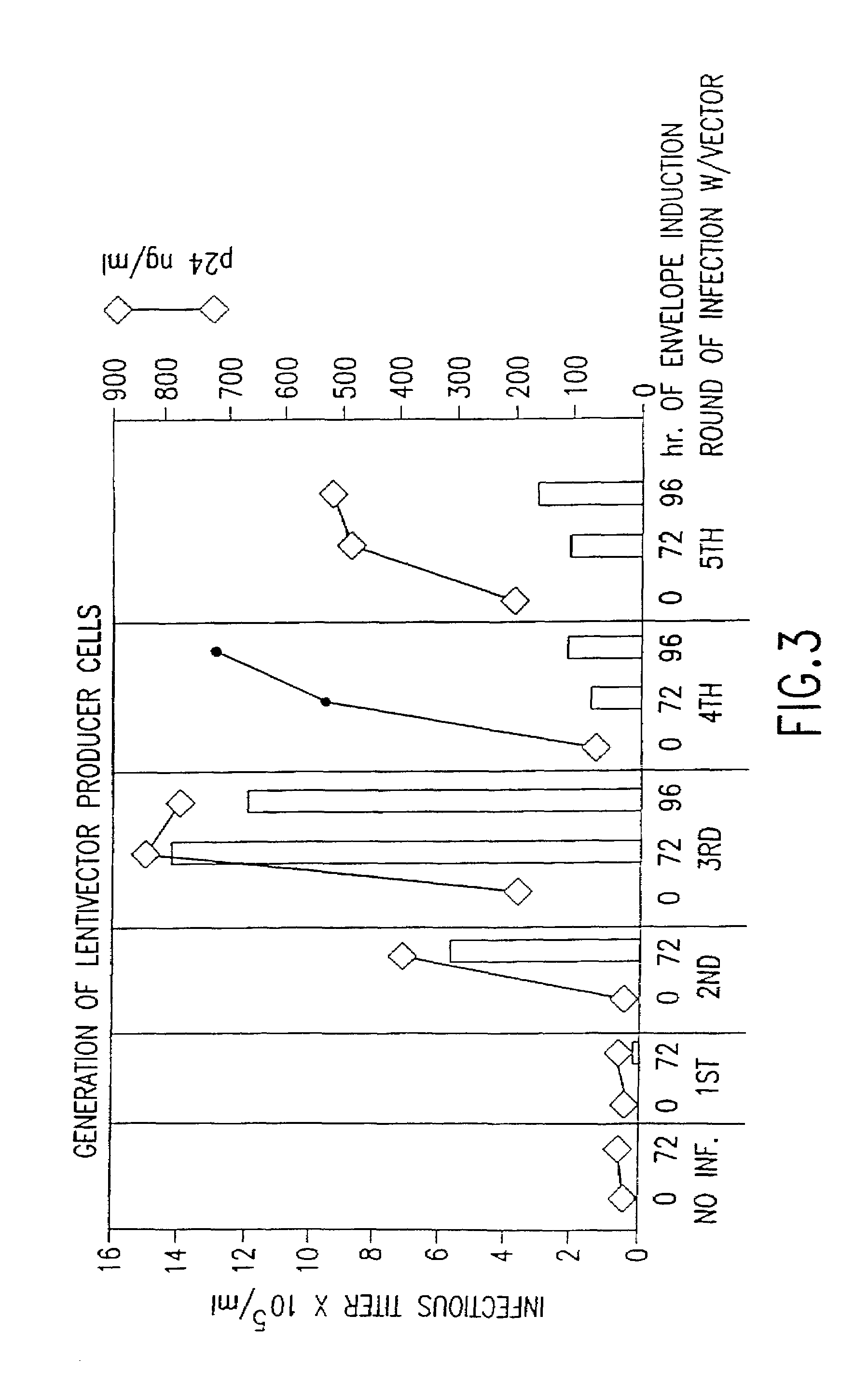Method and means for producing high titer, safe, recombinant lentivirus vectors
a technology of lentiviral packaging and vectors, applied in the direction of viruses/bacteriophages, biochemistry apparatus and processes, genetic material ingredients, etc., can solve the problems of unintentional introduction of vector recipients, high undesirable recombinant virus generation during vector production, and exponential loss of vector transduction potential, etc., to achieve high titer recombinant and rapid production
- Summary
- Abstract
- Description
- Claims
- Application Information
AI Technical Summary
Benefits of technology
Problems solved by technology
Method used
Image
Examples
example 1
Construction of Lentiviral Packaging Plasmids
[0118]The lentiviral packaging plasmids were derived from the plasmid pCMVΔR8.9 (ΔVprΔVifΔVpuΔNef) described previously in Zufferey et al., supra. All the remaining sequences of the nef gene in pCMVΔR8.9 were removed by digesting with XhoI and BstEII, filling in with Klenow and religating. The construction deleted 100 basepairs, joining the truncated env reading frame of HIV-1 to the genomic insulin polyadenylation site and yielding the plasmid pCMVΔR8.73.
[0119]In another embodiment of the invention, 133 basepairs of CMV-derived sequences downstream of the CMV promoter were deleted in the plasmid pCMVΔR8.73. That sequence contains a splice donor site and it was removed by digestion of the plasmid pCMVΔR8.73 with SacII and religation of the larger fragment, obtaining the plasmid pCMVΔR8.74.
[0120]In another embodiment of the invention, all the HIV-derived sequences remaining in the plasmid pCMVΔR8.74 upstream of the initiating codon of the ...
example 2
Construction of Lentiviral Transfer Vectors
[0122]The lentiviral transfer vector plasmids were derived from the plasmid pHR′-CMV-LacZ described previously in Naldini et al. Science, supra. pHR2 is a lentiviral transfer vector in which 124 bp of nef sequences upstream of the 3′LTR in pHR′ were replaced with a polylinker both to reduce HIV1 sequences and to facilitate transgene cloning. pHR2 was derived from pHR′-CMV-LacZ by replacing the 4.6 kb ClaI-Stul fragment with the 828 bp ClaI-StuI fragment generated by PCR using pHR′-CMV-LacZ as the template and the oligonucleotide, 5′-CCATCGATCACGAGACTAGTCCTACGTATCCCCGGGGACGGGATCCGCGGA ATTCCGTTTAAGAC-3′ (SEQ ID NO: 4) and 5′-TTATAATGTCAAGGCCTCTC-3′ (SEQ ID NO: 5) in a three-part ligation with a 4.4 kb StuI-NcoI fragment and a 4.5 kb NcoI-ClaI fragment from pHR′-CMV-LacZ.
[0123]In another embodiment of the invention, pHR3 is a lentiviral transfer vector in which 148 bp of env coding sequences (including an ATG) upstream of the Rev Response Elem...
example 3
Construction of 5′ LTR Chimeric Lentiviral Transfer Vectors
[0127]In another embodiment of the invention, the 5′ LTR of the lentiviral vector contains the enhancer and promoter from the U3 region of the Rous Sarcoma Virus (RSV) joined to the R region of HIV-1 (plasmid pRRL).
[0128]pRRL is a lentiviral transfer vector in which the enhancer and promoter (nucleotides −233 to −1 relative to the transcriptional start site) of RSV is precisely fused to the R region of HIV-1 using an oligonucleotide linker. pRRL was derived from plasmids pRT43.RSV.F3, see WO97 / 07225, and pHR2 by replacing the 3.4 kb EcoRI-HpaI fragment of pRT43.RSV.F3 with the 0.67 kb BglII-NotI fragment from pHR2 and the 1.7 kb NotI-StuI fragment from pHR2 along with a synthetic EcoRI-BglII oligonucleotide linker consisting of oligonucleotides 5′-AATTGCCGCATTGCAGAGATATTGTATTTAAGTGCCTAGCTCGATACAATAA ACGGGTCTCTCTGGTTAGACCA-3′ (SEQ ID NO:11) and 5′-GATCTGGTCTAACCAGAGAGACCCGTTTATTGTATCGAGCTAGGCACTTAAA TACAATATCTCTGCAATGCGGC-3′ ...
PUM
| Property | Measurement | Unit |
|---|---|---|
| temperatures | aaaaa | aaaaa |
| volumes | aaaaa | aaaaa |
| concentration | aaaaa | aaaaa |
Abstract
Description
Claims
Application Information
 Login to View More
Login to View More - R&D
- Intellectual Property
- Life Sciences
- Materials
- Tech Scout
- Unparalleled Data Quality
- Higher Quality Content
- 60% Fewer Hallucinations
Browse by: Latest US Patents, China's latest patents, Technical Efficacy Thesaurus, Application Domain, Technology Topic, Popular Technical Reports.
© 2025 PatSnap. All rights reserved.Legal|Privacy policy|Modern Slavery Act Transparency Statement|Sitemap|About US| Contact US: help@patsnap.com



